
Ludwig van Beethoven was a German composer and pianist. He is one of the most revered figures in the history of Western music; his works rank among the most performed of the classical music repertoire and span the transition from the Classical period to the Romantic era in classical music. His early period, during which he forged his craft, is typically considered to have lasted until 1802. From 1802 to around 1812, his middle period showed an individual development from the styles of Joseph Haydn and Wolfgang Amadeus Mozart, and is sometimes characterized as heroic. During this time, Beethoven began to grow increasingly deaf. In his late period, from 1812 to 1827, he extended his innovations in musical form and expression.
The Andante favori is a work for piano solo by Ludwig van Beethoven. In catalogues of Beethoven's works, it is designated as WoO 57.
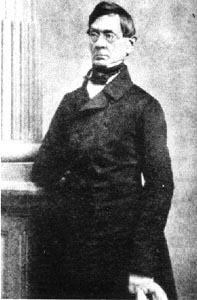
Anton Felix Schindler was an Austrian law clerk and associate, secretary, and early biographer of Ludwig van Beethoven.

Henry Edward Krehbiel was an American music critic and musicologist who was the chief music critic of The New York Tribune for more than forty years. Along with his contemporaries Richard Aldrich, Henry Theophilus Finck, W.J. Henderson and James Huneker, Krehbiel is considered part of the 'Old Guard', a group of leading New York–based music critics who first established a uniquely American school of criticism. A critic with a strong bend towards empiricism, he frequently sought out first hand experiences, accounts and primary sources when writing; drawing his own conclusions rather than looking to what other writers had already written. A meliorist, Krehbiel believed that the role of criticism was largely to support music that uplifted the human spirit and intellect, and that criticism should serve not only as a means of taste making but also as a mode to educate the public. His book How to Listen to Music was widely used as an instructional guide by the music consuming public in the United States during the last years of the 19th century and first several decades of the 20th century.

Elliot Forbes, known as "El", was an American conductor and musicologist noted for his Beethoven scholarship.
Wolfgang Amadeus Mozart (1756–1791) had a powerful influence on the works of Ludwig van Beethoven (1770–1827). Beethoven held Mozart in high regard; some of his music recalls Mozart's, he composed several variations on Mozart's themes and he modeled a number of his compositions on those of the older composer. Whether the two men ever actually met remains a matter of speculation among scholars.
Kaspar Anton Karl van Beethoven was a brother of the composer Ludwig van Beethoven.
Joseph Czerny was a pianist, composer, music publisher, and piano teacher from the Austrian Empire. He was not related to Carl Czerny.

Julie "Giulietta" Guicciardi was an Austrian countess and briefly a piano student of Ludwig van Beethoven. He dedicated to her his Piano Sonata No. 14, later known as the Moonlight Sonata.

Nikolaus Simrock was a German horn player at the court of the Elector of Cologne in Bonn and a music publisher. He was a friend of Ludwig van Beethoven and founder of the N. Simrock music publishing house. "Highly esteemed as a man and a musician", he remained in contact with Beethoven throughout the 1790s and is regarded as a "reliable witness" to Beethoven's years in Bonn.
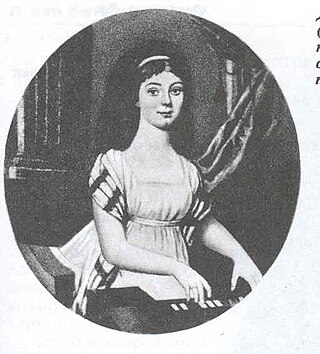
Dorothea von Ertmann was a German pianist.
Ignaz Umlauf (1746-1796) was an Austrian composer. He was Kapellmeister of the new German National Singspiel of Emperor Joseph II beginning from 1778 to his death. His son Michael Umlauf (1781-1842) was also a notable composer, and his daughter Elisabeth, mother of the composer Gustav Hölzel, was an operatic contralto.

Alois Isidor Jeitteles was an Austrian medical doctor, journalist and writer, best known for Ludwig van Beethoven's setting of his poem sequence, An die ferne Geliebte.
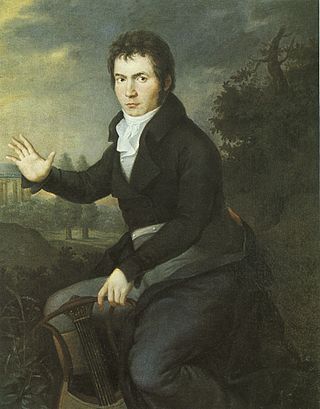
There are at least two surviving portraits created by German painter Joseph Willibrord Mähler in oils of the composer Ludwig van Beethoven.

Franz Xaver Gebauer, born in Prussian Silesia, was an organist, composer of church music, and choirmaster and music director of the Augustinian Church, Vienna. Before his early death he organised the 'Concerts Spirituels' which promoted German music in Vienna at a time when Italian opera was particularly popular.
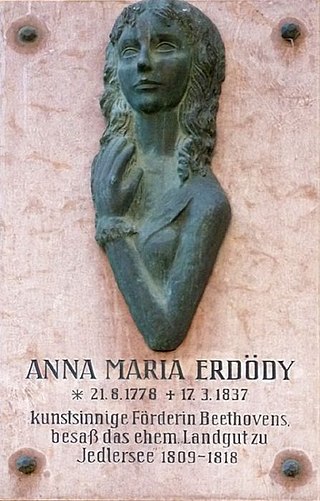
Countess Anna Maria (Marie) von Erdődy was a Hungarian noblewoman and among the closest confidantes and friends of Ludwig van Beethoven. Dedicatee of four of the composer's late chamber works, she was instrumental in securing Beethoven an annuity from members of the Austrian high nobility.
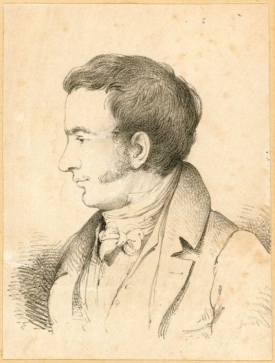
Baron Ignaz von Gleichenstein was a German aristocrat and amateur cellist. He became a close friend of Ludwig van Beethoven, as well as being one of his most ardent supporters. Alongside Countess Marie Erdödy, Gleichenstein played a role in securing Beethoven a lifetime annuity from members of the Austrian high nobility.
Severin Anton Averdonk, real name Anton Clemens Averdonk, was a German Roman Catholic clergyman and poet who represented the ideals of the Age of Enlightenment and the French Revolution. He wrote the texts for at least one cantata that Ludwig van Beethoven composed.
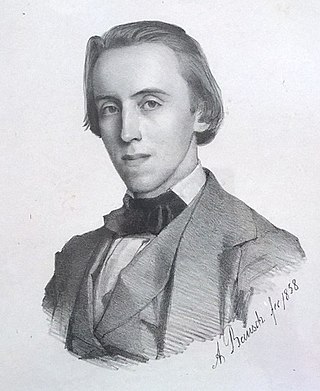
Hermann Deiters was a German writer about music, and educator. He is known for his writings about Ludwig van Beethoven, publishing the composer's first major biography as a translation of Alexander Wheelock Thayer's work.

Beethoven with the Manuscript of the Missa Solemnis is a portrait of Ludwig van Beethoven by Joseph Karl Stieler, completed in 1820. It shows Beethoven holding a manuscript of his Missa solemnis. The painting is held by the Beethoven-Haus in Germany. Variations on the portrait were produced by, among others, Josef Kriehuber and Andy Warhol.














